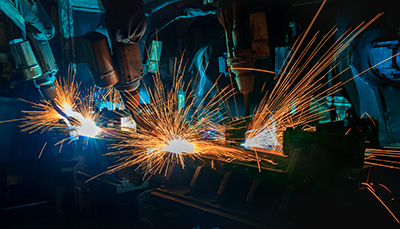What Does the Future Hold for Robotic Welding?

Once considered a futuristic fantasy, robotic welding has transformed the manufacturing landscape over the past few decades. Thanks to continuous advancements in technology and research, it's now a cornerstone of modern production, enhancing efficiency, precision, and safety across industries.
As we look ahead, the future of robotic welding is both exciting and complex. With the rise of smart factories and Industry 4.0, we can expect even more intelligent, adaptable, and integrated robotic systems that will redefine what’s possible in welding applications.
The Push for Innovation
Staying ahead in the competitive world of manufacturing means embracing innovation—especially in the field of robotic welding. The demand for faster, more flexible, and more accurate arc welding solutions is growing rapidly, driven by the need to handle smaller, more intricate parts with greater precision.
Robotic arms are evolving to offer more degrees of freedom, allowing them to reach difficult angles and perform complex tasks efficiently. At the same time, safety remains a top priority, with new designs incorporating advanced sensors and real-time monitoring to prevent accidents and improve operator confidence.
Additionally, the integration of connected systems is becoming essential. Companies are increasingly relying on data-driven insights to optimize their operations. Genesis Systems offers Connected Solutions that provide real-time performance analytics, helping manufacturers predict maintenance needs, reduce downtime, and maximize productivity.
Operational Challenges Ahead
While automation brings many benefits, it also introduces new challenges. One key issue is managing the flow of materials and parts efficiently. As demand becomes more dynamic, companies must balance production with consumer needs without overstocking or under-producing.
Another challenge lies in workforce development. As robots take over more of the welding tasks, there's a growing need for skilled technicians who can program, maintain, and troubleshoot these systems. Training programs must evolve to keep up with the pace of technological change, ensuring that operators remain proficient and capable of handling advanced robotic systems.
Despite these hurdles, one thing is clear: the future of robotic welding is bright. With continued investment in R&D, smarter automation, and better integration with digital platforms, the industry is poised for significant growth. Companies like Genesis Systems are at the forefront, offering cutting-edge robotic welding solutions that help businesses stay competitive and efficient in an ever-changing market.
Posted in Robotic WeldingCurtain Wall Profiles,Aluminium Curtain Wall Profiles,Curtain Wall Mullion Profiles,curtain wall system,glass curtain wall
Sinogar Metal Co.,Ltd , https://www.sedinoaluminium.com
